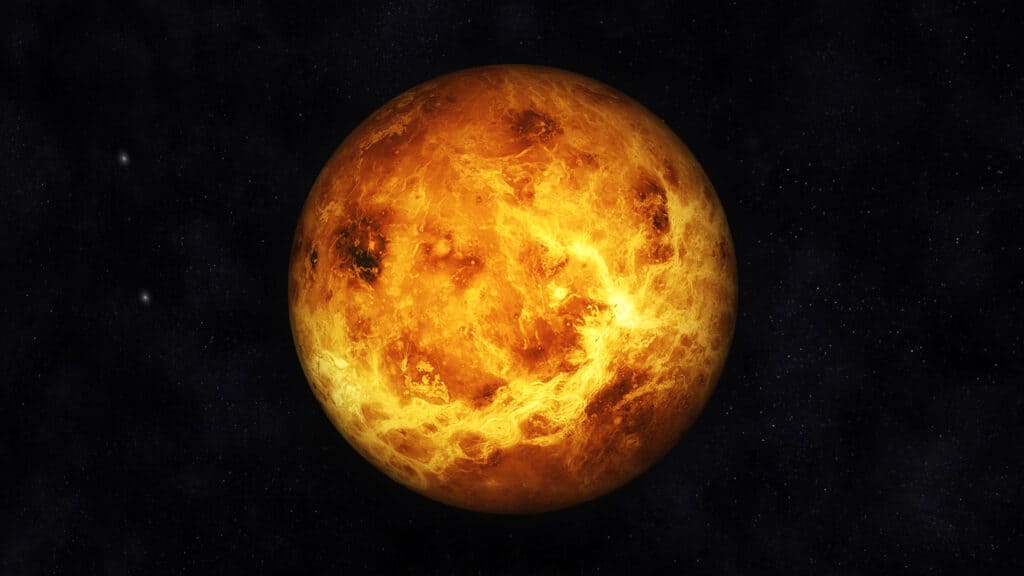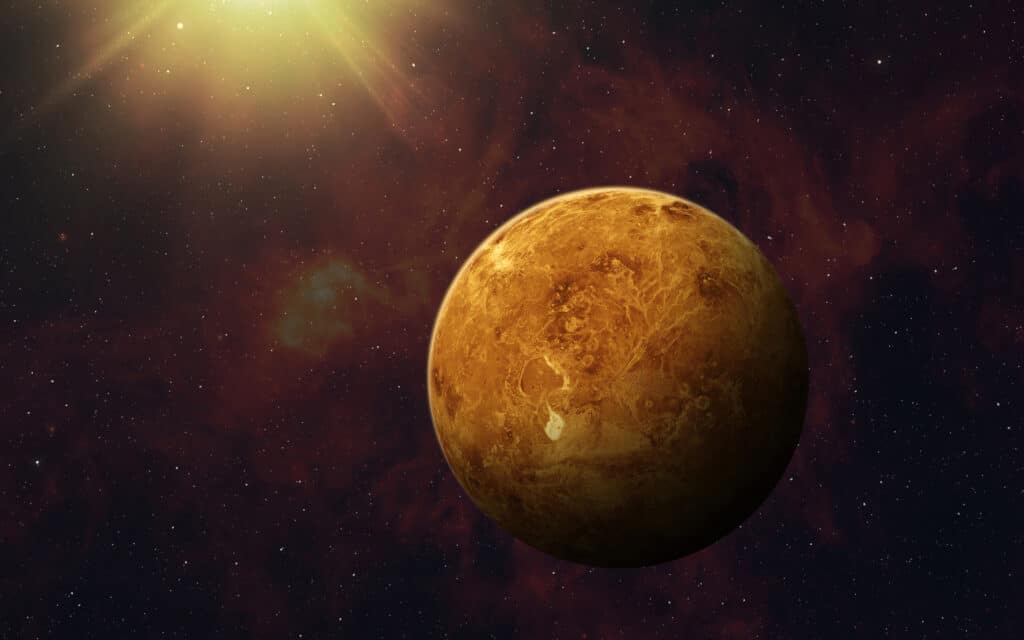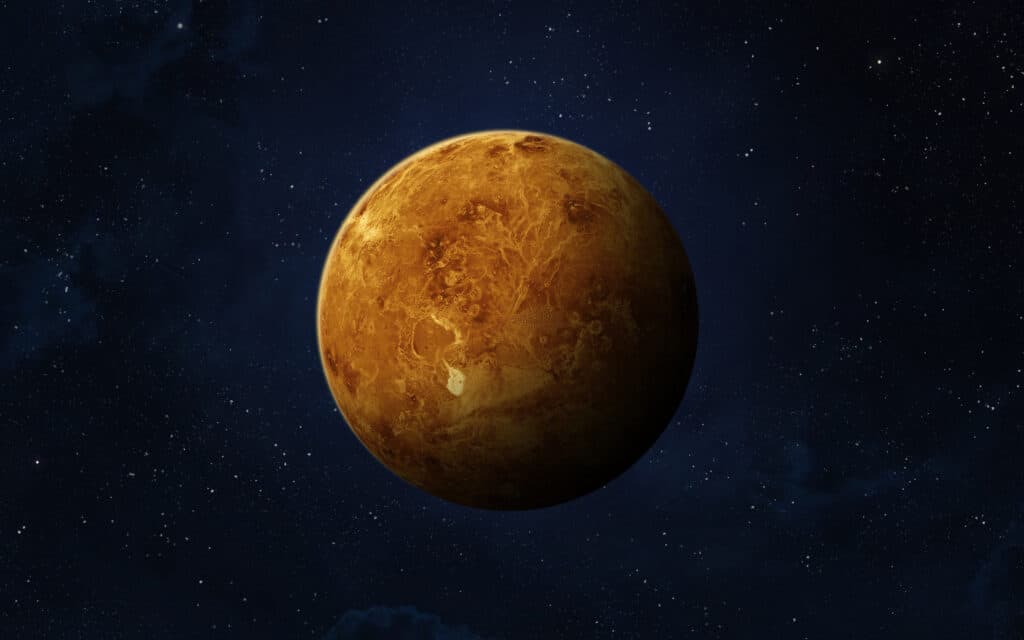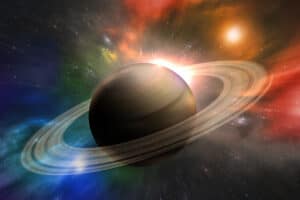If you’re ever thinking about going someplace warm in the middle of a frigid winter, you probably shouldn’t think about going to Venus.
Surprisingly, Venus is actually pretty similar to Earth in many ways. Many scientists believe that these two planets may have formed at the same time out of a condensing nebulosity about 4.5 billion years ago.
However, Venus, the second planet from the Sun, is 30% closer to the Sun than Earth. The surface of Venus is the hottest in the solar system, even hotter than that of Mercury!
Assuming that humans found some way to withstand the heat, you might wonder what life would be like there. For example, you might want to know how much you’d weigh on Venus.
How Much Would You Weigh on Venus?

Anyone and anything will weigh 91% of their weight on Earth if transported to Venus.
©iStock.com/3quarks
Even though Venus is way too hot for any earthly life to be able to even visit, it has a solid surface to stand on. The size, mass, volume, and density of Venus are very similar to those parameters of Earth. Because of this, your weight on Venus would not be that different than your weight here.
On Venus, you would weigh about 91% of what you weigh on Earth. For example, a 200-pound person would weigh 182 pounds on Venus.
Here’s a table showing what individuals of various masses would weigh on Venus (rounded to the nearest whole number):
| Weight on Earth | Weight on Venus |
|---|---|
| 100 pounds | 91 pounds |
| 105 pounds | 96 pounds |
| 110 pounds | 100 pounds |
| 115 pounds | 105 pounds |
| 120 pounds | 109 pounds |
| 125 pounds | 114 pounds |
| 130 pounds | 118 pounds |
| 135 pounds | 123 pounds |
| 140 pounds | 127 pounds |
| 145 pounds | 132 pounds |
| 150 pounds | 137 pounds |
| 155 pounds | 141 pounds |
| 160 pounds | 146 pounds |
| 165 pounds | 150 pounds |
| 170 pounds | 155 pounds |
| 175 pounds | 159 pounds |
| 180 pounds | 164 pounds |
| 185 pounds | 168 pounds |
| 190 pounds | 173 pounds |
| 195 pounds | 177 pounds |
| 200 pounds | 182 pounds |
| 205 pounds | 187 pounds |
| 210 pounds | 191 pounds |
| 215 pounds | 196 pounds |
| 220 pounds | 200 pounds |
| 225 pounds | 205 pounds |
| 230 pounds | 209 pounds |
| 235 pounds | 214 pounds |
| 240 pounds | 218 pounds |
How Is Weight on Venus Determined?
If you’re curious about why you would weigh what you would on Venus, it would be a good idea to learn (or refresh yourself on!) the difference between mass and weight. Your mass is a measure of how much matter is in your body. Your weight is somewhat different; this is a measure of the attraction between you and the center of the planet.
Sir Isaac Newton derived an equation that enables us to calculate the weight of objects on any other planet: F=Mm/r2, where M is the planet’s mass, m is your mass, and r is the distance between your body and the center of the planet.
Venus has about 86.6% of the volume of Earth and 81.5% of Earth’s mass. It has a mean radius of approximately 3,761 miles (6,052 kilometers), while Earth’s mean radius is about 3,959 miles (6,371 kilometers). The density of these two planets is fairly similar.
The majority of planets in the solar system, including Earth, spin at such a rapid pace that they end up bulging just a little bit at the equator so that the radius is a little bit higher around the equator than it is from pole to pole. However, Venus is different in that it is basically a sphere; the radius is almost essentially the same all over the planet.
Because the volume (and thus radius) and mass of Venus and Earth are quite similar, it follows that your weight on Venus would be pretty close to your weight on Earth.
What Would Other Things Weigh on Venus?
Any person or object in your life would weigh 91% of what it does now if you were to take it to Venus.
One example is a mid-size car. Weighing 3,000 to 3,500 pounds on Earth, this object would weigh 2,730 to 3,185 pounds on Venus. A standard basketball, weighing about 22 ounces (1 pound, 6 ounces) on our planet, would weigh slightly less at about 20 ounces on Venus. An 8.6-ounce gallon of milk here would weigh 7.8 ounces on Venus.
All you need to do to know how much something would weigh on the planet Venus is multiply its weight as you know it by a factor of 0.91.
How Much Does Venus Weigh?

Venus has a mass of 4.867 × 10
24kilograms, or 1.073 × 10
25pounds – about 81.5% of Earth’s mass.
©iStock.com/buradaki
The mass of Venus is 4.867 × 1024 kilograms, or 1.073 × 1025 pounds, or 81.5% of the mass of Earth. Venus also has 86.6% of Earth’s volume.
Earth is divided into layers – an outer crust, a mantle, and a core. Because it is so similar to Earth in terms of size and density, scientists believe that Venus also has a crust, mantle, and core.
Unlike Earth, there is no evidence for plate tectonics on Venus. One possible reason for this is that the crust is too strong (due to a lack of water on the planet) for parts of it to move sideways and into the mantle. Because of this, there isn’t as much heat loss from Venus as there is from Earth.
Earth is very unique in that the majority of its surface, about 70.8% in fact, is covered in water. The terrain of Earth also has many variations, with canyons, trenches, volcanoes, mountains, and more.
Venus, on the other hand, doesn’t have very much variation at all – the majority of the planet is made up of smooth, volcanic plains, with the exception of two large highlands that contain most of the rough features present on the planet.
The crust of Earth is constantly being recycled by the movement of tectonic plates, and the average age of this crust is thought to be about 100 million years old. Since this doesn’t happen on Venus, there has been much more time for volcanoes to form.
The crust of Venus has been shaped and smoothed mostly by volcanic activity and is thought to be between 300 and 600 million years old.
Could Any Life Survive on Venus?

Scientists don’t believe life on Venus is possible, but some believe microorganisms may be present in the Venusian atmosphere.
©iStock.com/buradaki
The majority of scientists don’t think it’s possible for life to exist on Venus. As far as we know, there’s no water. Also, the surface temperature on Venus ranges from 820 to 900 degrees Fahrenheit – hot enough to melt lead. The extremes on the planet, which also include intense wind and frequent volcanic activity, make it inhospitable.
Additionally, the atmosphere of Venus is extremely thick, with an air pressure on the surface that is more than 90 times what we experience on Earth. Spacecraft that have landed on Venus haven’t been able to survive for more than about an hour without being crushed and melted.
Conditions on Venus were much milder at one point. It’s possible that water actually existed for one to three billion years in the beginning. The Sun was not as bright at the time, emitting ultraviolet rays and high-energy particles to surrounding planets.
However, after this, oceans evaporated, and a runaway greenhouse effect trapped a significant amount of energy from the Sun. Because of this effect, Venus is now actually hotter than Mercury, despite the fact that the latter planet is closer to the Sun.
Certain microorganisms, referred to as extremophiles, could theoretically survive in certain zones of the atmosphere which contain nutrients, some water, and access to sunlight with clouds to provide protection from ultraviolet rays. Some scientists believe it to be possible that these organisms adapted to changing conditions and moved from the surface into the atmosphere.
Because of the constant volcanic activity on Venus, fossils are unlikely to be found on the surface. However, we can’t rule out the possibility of life in the clouds, past or present.
.
The photo featured at the top of this post is © iStock.com/buradaki
Thank you for reading! Have some feedback for us? Contact the AZ Animals editorial team.






